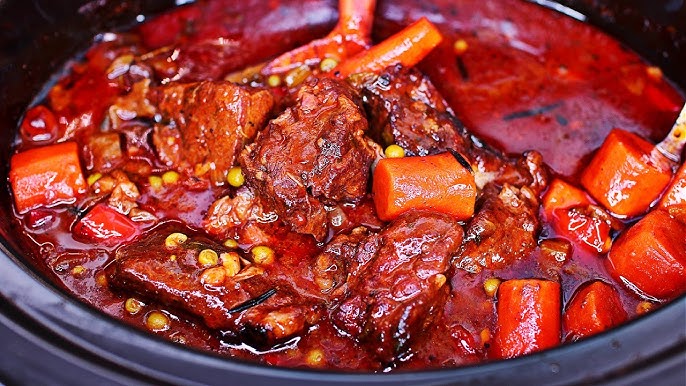Beef Stew Crockpot Recipe: There’s just something magical about tossing ingredients into a crockpot, setting it, and letting the slow simmer do all the heavy lifting. A crockpot (or slow cooker) isn’t just a lazy cook’s dream—it’s a secret weapon for creating intensely flavorful, melt-in-your-mouth beef stew. The beauty of slow cooking lies in the way it allows flavors to develop and blend gradually, turning simple ingredients into something that tastes like it took hours of active cooking. And guess what? It did take hours—but the appliance did it, not you.
Using a crockpot also means you’re not stuck babysitting a pot on the stove. You can go about your day, run errands, work from home, or just chill while your dinner cooks itself. Plus, because it uses low and steady heat, even tougher cuts of beef become tender and juicy by the end. This method locks in moisture, so every bite is full of rich, savory goodness. If you’ve ever wanted to master the art of comfort food with zero stress, this is the recipe for you.
The Perfect Comfort Food for Any Season
While many think of beef stew as a cold-weather classic, it’s actually a year-round winner. Sure, it’s hearty enough for winter nights, but it’s also great for lazy Sunday dinners in spring or autumn. Even in summer, when you want a home-cooked meal without heating up the kitchen, your crockpot has you covered. The flexibility is what makes it such a kitchen MVP. Add some crusty bread or a side of mashed potatoes, and you’ve got a meal that feels like a warm hug in a bowl.
Ingredients for Classic Crockpot Beef Stew
Essential Ingredients You’ll Need
To make the best crockpot beef stew, start with the right ingredients. You don’t need anything fancy—just fresh, wholesome components that come together to make magic.
Here’s your shopping list:
- 2 pounds of beef chuck roast (cut into 1-inch cubes)
- 4 medium carrots (peeled and sliced)
- 3 large potatoes (cut into chunks)
- 3 celery stalks (sliced)
- 1 large onion (chopped)
- 3 cloves garlic (minced)
- 4 cups beef broth (preferably low sodium)
- 2 tablespoons tomato paste
- 1 tablespoon Worcestershire sauce
- 2 teaspoons salt (adjust to taste)
- 1 teaspoon black pepper
- 1 teaspoon dried thyme
- 1 bay leaf
- 2 tablespoons flour or cornstarch (optional, for thickening)
- 2 tablespoons olive oil (for browning meat)
These basic ingredients build the base of your stew. They’re all about earthy richness and deep flavor that develops over time. You can usually find all of them at your local grocery store—no need to hunt down rare spices or gourmet items.
Optional Add-ins for Extra Flavor
Want to jazz it up a bit? Here are a few extras you can toss in depending on your taste:
- 1 cup frozen peas (add in the last 30 minutes of cooking)
- 1/2 cup red wine (adds depth and richness)
- Mushrooms (for an umami boost)
- Sweet potatoes instead of regular potatoes (for a twist)
- A splash of balsamic vinegar (for tanginess)
Feel free to make it your own. The beauty of crockpot cooking is that it’s incredibly forgiving and customizable.
Preparing Your Ingredients Properly
Cutting the Beef for Tender Results
Not all beef cuts are created equal when it comes to stew. You want something that holds up to long cooking times but also becomes incredibly tender. Chuck roast is the gold standard—it’s affordable, marbled with fat, and absolutely perfect for slow cooking.
Start by trimming off any large chunks of fat, then cut the meat into bite-sized, 1-inch pieces. The size matters: too small and they’ll disintegrate; too big and they might not cook evenly. If your butcher can cut it for you, even better! But doing it yourself lets you control the quality and the size.
Pro tip: Pat the beef dry with paper towels before browning. Moisture is the enemy of a good sear. You want that deep golden crust—it adds so much flavor to the final dish.
Prepping Vegetables the Right Way
Veggies are more than just fillers—they bring texture, sweetness, and color to your stew. But they need to be prepped with care so they hold up after hours in the crockpot.
- Carrots: Peel and cut into thick rounds. Thinner slices might get mushy.
- Potatoes: Russets break down more, giving a thicker stew, while red or Yukon golds hold their shape. Cut into 1- to 2-inch chunks.
- Celery: Slice into even pieces to avoid stringy bits.
- Onions and garlic: Roughly chopped and minced—these are flavor builders.
Once you’ve got everything chopped and ready, the actual cooking process becomes a breeze. Mise en place (having everything prepped) is your best friend here.
Step-by-Step Cooking Instructions
Step 1: Searing the Beef
Before you even touch the crockpot, there’s one crucial step that makes a massive difference in flavor—searing the beef. You might be tempted to skip this part and just throw everything into the pot, but don’t. Taking the time to brown your meat adds a layer of richness and complexity that slow cooking alone just can’t match.
Here’s how to do it:
- Heat 2 tablespoons of olive oil in a skillet over medium-high heat.
- Working in batches, add the beef cubes to the pan—don’t crowd them, or they’ll steam instead of sear.
- Let each side brown for about 2-3 minutes. You’re looking for a deep golden crust.
- Remove the seared beef and set it aside.
You don’t need to cook the meat all the way through—it’ll finish in the crockpot. This step is just about locking in those savory, umami-packed flavors.
Step 2: Layering Ingredients in the Crockpot
Now it’s time to build the stew. Think of your crockpot like a flavor layer cake. The way you stack things matters more than you’d think.
Start with the vegetables. Place your potatoes, carrots, celery, onions, and garlic at the bottom of the pot. These heartier veggies can take the heat and help create a base that soaks up all the meat juices as they cook down.
Next, add your seared beef on top. Sprinkle in the salt, pepper, thyme, and toss in the bay leaf. If you’re using tomato paste, Worcestershire sauce, and wine (optional), mix them with the beef broth in a bowl before pouring over everything. This way, the flavors distribute more evenly throughout the pot.
Gently stir the ingredients once or twice just to combine slightly—don’t overmix or you might end up with mushy veggies by the end.
Step 3: Cooking Time and Temperature Settings
This is where the magic happens—and you barely have to lift a finger.
You’ve got two options depending on your schedule:
- Low setting: Cook for 8-10 hours. This is ideal for maximum flavor and tenderness.
- High setting: Cook for 4-6 hours if you’re short on time.
Halfway through the cooking time, give the stew a light stir to ensure everything is cooking evenly. In the last hour of cooking, if you prefer a thicker stew, mix 2 tablespoons of flour or cornstarch with cold water and stir it into the crockpot. This slurry will thicken the broth beautifully without altering the taste.
When done, the beef should fall apart with a fork, and the vegetables should be tender but not mushy. Your house will smell incredible, and your stomach will thank you.
Tips for Enhancing Flavor
Seasoning Suggestions
Great flavor doesn’t just happen—it’s built with intention. Beyond the salt and pepper, don’t be afraid to layer flavors with spices and herbs. Here are a few seasoning ideas that can elevate your crockpot beef stew:
- Smoked paprika: Adds a subtle smoky depth.
- Rosemary or thyme sprigs: Throw them in whole and remove before serving.
- A dash of soy sauce or miso paste: For a savory umami punch.
- A splash of vinegar or lemon juice: Added at the end, it brightens the entire dish.
Adjust seasonings as you go, but always taste before serving. Crockpot dishes can sometimes mute flavors over time, so a final seasoning adjustment can make a big difference.
Thickening the Stew
Nobody likes a watery stew. If your broth is too thin, there are several ways to thicken it:
- Cornstarch or flour slurry: Mix 2 tablespoons with a bit of cold water and stir into the stew.
- Mash some of the potatoes: They’ll dissolve into the broth and thicken naturally.
- Add a roux: If you’re feeling fancy, make a butter-flour roux on the stovetop and stir it in during the last 30 minutes.
Whatever method you choose, give it a bit of time to blend in before making further adjustments.
Serving Suggestions
Best Sides to Serve with Beef Stew
Beef stew is hearty enough to stand alone, but pairing it with the right side can turn it into an unforgettable meal. Here are a few winning combos:
- Crusty bread or dinner rolls: Perfect for soaking up all that delicious broth.
- Mashed potatoes: Serve the stew over a scoop for the ultimate comfort food mashup.
- Steamed rice or egg noodles: A great base if you want to stretch your stew a little further.
- A fresh green salad: Adds a crisp contrast to the rich, savory stew.
- Roasted brussels sprouts or green beans: For a little extra veggie power.
Keep it simple, and let the stew be the star.
Storing and Reheating Leftovers
Leftovers? Lucky you. Beef stew actually tastes better the next day as the flavors continue to meld.
To store:
- Cool the stew to room temperature.
- Transfer to an airtight container.
- Keep in the fridge for up to 4 days or freeze for up to 3 months.
To reheat:
- On the stove: Simmer over low heat, stirring occasionally.
- In the microwave: Use a microwave-safe bowl, cover loosely, and heat in 1-minute bursts, stirring between.
Add a splash of broth or water if it’s too thick after refrigeration or freezing.
FAQs about Beef Stew Crockpot Recipe
Q1: Can I put raw beef in a crockpot for stew?
Yes, you can. However, browning the beef first in a skillet adds deeper flavor and improves texture. It’s optional, but definitely recommended for that rich, hearty taste.
Q2: How long does beef stew take in a crockpot?
On low, it takes about 8 hours. On high, it’ll be ready in 4 to 5 hours. Just make sure the beef is fork-tender and the vegetables are soft.
Q3: What cut of beef is best for crockpot stew?
Use chuck roast—it’s affordable, well-marbled, and becomes meltingly tender during the long slow cook. Avoid lean cuts; they dry out.
Q4: Can I make beef stew the night before?
Absolutely. In fact, beef stew tastes even better the next day! The flavors deepen as they sit. Just store it in an airtight container in the fridge.
Q5: Can I freeze leftover crockpot beef stew?
Yes, beef stew freezes beautifully. Let it cool completely, then store in freezer-safe containers for up to 3 months. Thaw overnight in the fridge and reheat on the stove.
Q6: How do I thicken my beef stew in the crockpot?
Mix 1–2 tablespoons of cornstarch with cold water and stir into the stew during the last 30 minutes of cooking. It’ll thicken up nicely.
Q7: Can I add potatoes and carrots at the beginning?
Yes! Chunky-cut carrots and potatoes can cook the full time in the crockpot without turning to mush. Just don’t dice them too small.
Q8: What spices go well in crockpot beef stew?
Classic stew spices include bay leaf, thyme, rosemary, garlic, and black pepper. A dash of Worcestershire sauce or red wine can also boost flavor.
Conclusion
Whether you’re serving it up on a frosty winter night, meal prepping for the week ahead, or simply craving a bowl of homemade goodness, this crockpot beef stew has your back. Don’t be afraid to make it your own, either. Swap out ingredients, tweak the spices, or add your favorite vegetables. The recipe is forgiving and flexible, just like any good comfort food should be.
So dust off that crockpot, grab your chopping board, and let’s get simmering. Your kitchen is about to smell amazing, and your taste buds are in for a treat.



